

Culture of Empathy Builder: Marshall Rosenberg. "I recommend allowing others the opportunity to fully express themselves before turning our attention to solutions or requests for relief.

When we proceed too quickly to what people might be requesting, we may not convey our genuine interest in their feelings and needs; instead, they may get the impression that we're in a hurry to either be free of them or to fix their problem. Furthermore, an initial message is often like the tip of an iceberg; it may be followed by yet unexpressed, but related - and often more powerful - feelings.
By maintaining our attention on what's going on within others, we offer them a chance to fully explore and express their interior selves. We would stem this flow if we were to shift attention too quickly either to their request or to our own desire to express ourselves. " Marshall B. What evidence is there that we've adequately empathized with the other person? A second even more obvious sign is that the person will stop talking.
Have you ever been surfing? Nonviolent Communication is an Instrument of Psychic Terror - Morten Tolboll. Inner Empathy Opening To The Heart Of Self Compassion. The Power of Focusing, the Power of NVC, and processing. The Power of Focusing, The Power of NVC, and processing....
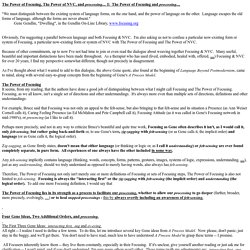
I: The Power of Focusing and processing.... "We must distinguish between the existing system of language forms, on the one hand, and the power of language on the other. Language escapes the old forms of language, although the forms are never absent. " Gene Gendlin, "Dwelling", in the Gendlin On-Line Library, www.focusing.org Obviously, I'm suggesting a parallel between language and both Focusing & NVC.
Because of other commitments, up to now I've not had time to join or even read the dialogue about weaving together Focusing & NVC. As I've thought about what I wanted to add to this dialogue, the above Gene quote, also found at the beginning of Language Beyond Postmodernism, came to mind, along with several easy-to-grasp concepts from the beginning of Gene's A Process Model. Marshall B. Rosenberg: Books, Biography, Blog, Audiobooks, Kindle. The Power of Focusing, The Power of NVC II: Healing Alienating Spring 1985, Sunday night, and Marshall Rosenberg, in Chicago for a workshop at our home, unexpectedly drops by for Changes.
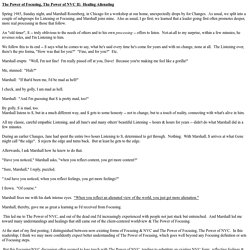
As usual, we split into a couple of subgroups for Listening or Focusing, and joins mine. Also as usual, I go first; we learned that a leader going first often promotes deeper, more real processing in those that follow. An "old timer", S -- truly oblivious to the needs of others and to his own processing -- offers to listen. NVC - NVC.pdf. Microsoft Word - ThesisMADRFinalDraft_0208.doc - MLittle_Thesis0408.pdf. Voluntary Visions. The Language of Choice, as Juxtaposed to the Ever-Present Language of Obligation by Darrell Becker Glossary empathy (n.) – the ability to understand and share the feelings of another. 1903, from German Einfühlung (from ein “in” + Fühlung “feeling”), coined 1858 by German philosopher Rudolf Lotze (1817-1881) as a translation of Greek empatheia “passion, state of emotion,” from en “in” + pathos “feeling”.

A term from a theory of art appreciation that maintains appreciation depends on the viewer’s ability to project his personality into the viewed object. choice (n.) – an act of selecting or making a decision when faced with two or more possibilities. mid-14c., “that which is choice,” from choice (adj.) blended with earlier chois (n.) Introduction Introduction to the Trivium Method of Critical Thinking: Relevant to the discussion of how NVC fits with the Trivium, it helps to spell out what I mean by the Trivium method: Accueil. Domination Systems. Domination systems as revealed by language Marshall Rosenberg describes a domination system as follows: "...By systems I mean governments, organizations, institutions that regulate human affairs.
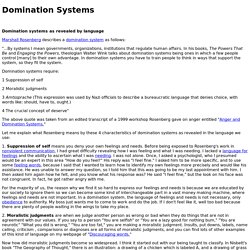
In his books, The Powers That Be and Engaging the Powers, theologian Walter Wink talks about domination systems being ones in which a few people control [many] to their own advantage. In domination systems you have to train people to think in ways that support the system, so they fit the system. Northwest Compassionate Communications. The following is a slightly edited transcript of part of a workshop on anger led by Dr.

Rosenberg in England in May of 1999. Dr. The subtle violence of nonviolent language. These thoughts are occasioned by a training video (1) by Marshall Rosenberg, a 200-minute condensation of a full-day workshop given in San Francisco by his Center for Nonviolent Communication.
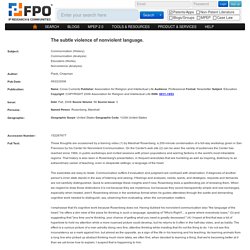
On the Center's web site (2) can be seen the variety of audiences the Center has reached since 1984, in public workshops and invited sessions with prison populations and warring factions in the world's most intractable regions. How to Practice Nonviolent Communication (with Illustrations) Reader Approved Three Methods:Practicing NVCHandling BoundariesCommunicating WellCommunity Q&A Nonviolent Communication (NVC)[1] includes a simple method for clear, empathic communication, consisting of four areas of focus: ObservationsFeelingsNeedsRequests.

Fiches pratiques ENV - Album photos. Marshall Rosenberg (1) Marshall Rosenberg (2) Marshall Rosenberg (3) Les mots sont des fenêtres ou bien ce sont des murs : Introduction à la Communication Non Violente: Amazon.fr: Marshall Rosenberg, Arun Gandhi, Charles Rojzman, Farrah Baut-Carlier. Communication non-violente (Rosenberg) Certaines informations figurant dans cet article ou cette section devraient être mieux reliées aux sources mentionnées dans les sections « Bibliographie », « Sources » ou « Liens externes » (novembre 2008).
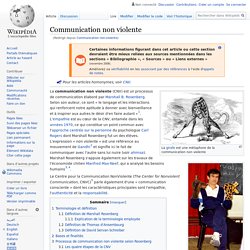
Améliorez sa vérifiabilité en les associant par des références à l'aide d'appels de notes. Pour les articles homonymes, voir CNV. La girafe est une métaphore de la communication non violente. Les écueils des techniques de communication non-violentes. Putain, la communication non violente, ça me gave ! : 2yeux2oreilles. Un matin vers 8h30, je monte dans le bus.
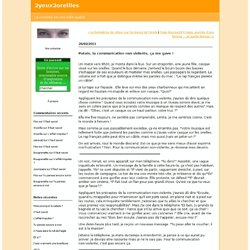
Sur un strapontin, une jeune fille, casque vissé sur les oreilles. Quand le bus démarre, j'entend le boum boum des basses s'échapper de ses écouteurs et marteler mes oreilles. Les passagers la regardent. Le volume est si fort que je distingue même les paroles du mec : "Le rap français pèèète un câble". Je lui tape sur l'épaule . Appliquant les préceptes de la communication non-violente, j'aurais dû dire quelque chose comme " Quand vous écoutez votre musique à un niveau sonore élevé, je me sens en colère parce que je le prends comme un manque de respect des autres" mais j'ai dit : "Dîtes, c'est un casque ou un haut-parleur, votre truc ?
" Elle me fixe toujours, ne semble pas comprendre.